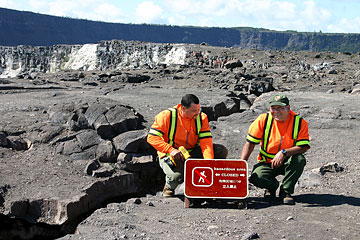 COURTESY JAY ROBINSON / NATIONAL PARK SERVICE
Hawaii Volcanoes National Park workers Rick Ganigan, right, and Herbert Botelho put up warning signs after an existing crack next to Halemaumau Crater widened slightly during yesterday's earthquake near the summit of Kilauea Volcano. CLICK FOR LARGE |
|
Earthquake hits Big Isle near the top of Kilauea
Little damage is reported in the 'moderate' shake
HILO » A moderately large earthquake that shook parts of the Big Island yesterday did little damage but left scientists wondering what to make of it.
At magnitude 4.7, it was largest in at least 50 years in the area where it occurred, just east of Kilauea's summit, the Hawaiian Volcano Observatory said.
But the shaking was still considered "moderate," and the island has experienced many stronger quakes in other areas.
An area south of the summit has been experiencing swarms of small quakes for two weeks, but this 9:13 a.m. quake hit an unrelated area a mile or two east of those swarms.
HILO » An unusual magnitude-4.7 earthquake near the summit of Kilauea Volcano yesterday was felt as far west as South Kohala on the other side of the island but did little damage. Weaker aftershocks followed.
In Hawaii Volcanoes National Park, part of the interior wall of Halemaumau Crater collapsed, existing cracks in the earth widened slightly and new ones formed, said park spokeswoman Mardie Lane.
At the Volcano Store, a few miles away, wine bottles on one shelf were knocked off, although no major damage resulted, said manager Ardis Onouye.
The quake, with a strength considered "moderate," was felt as far as 55 miles away on the other side of the island, the Hawaiian Volcano Observatory said. That was probably because the area around Waimea and Waikoloa contains a lot of deep soil that can magnify the effects of an earthquake, said observatory head Jim Kauahikaua.
The main quake took place on Kilauea's upper east rift near the extinct Puhimau Crater, about a mile southeast of Crater Rim Drive, which circles Kilauea's 3-mile-wide caldera. It was centered a little more than a mile deep, considered shallow.
Since 1998 a few shallow quakes with a magnitude greater than 4 have taken place in the area, but this was the largest in the area in at least 50 years, the observatory said.
In other areas, much stronger quakes have taken place, such as the 7.2 earthquake along the Puna Coast in 1975 and the 6.7 quake off the Kona Coast on Oct. 15.
Kauahikaua said the location and strength yesterday surprised him, and the observatory staff did not have an immediate explanation.
Such moderately large quakes usually occur more directly south of Kilauea's caldera, where they indicate the whole south side of Kilauea is sporadically slipping toward the sea.
The observatory said yesterday's quake at 9:13 a.m. was apparently part of swarms of smaller quakes that have been taking place a mile or two to the west since May 12. A 4.1-magnitude aftershock took place at 9:33 a.m. about a mile east of the first quake.
The observatory has linked the previous swarms to magma rising from deep in the earth and filling a so-called storage area underneath the summit of Kilauea. Most of the magma gets squeezed down the east rift and erupts in the area of Puu Oo, but more and more has been retained under the summit area, Kauahikaua said.
The entire summit has been inflating for several years, but the process accelerated in 2006. It slowed toward the end of the year, then picked up again this year, he said.
Despite all of that, the additional magma under the summit has been "minimal," the observatory has said.
Hawaii County Civil Defense said it received about 15 phone calls about the quake but that no one reported damage.

